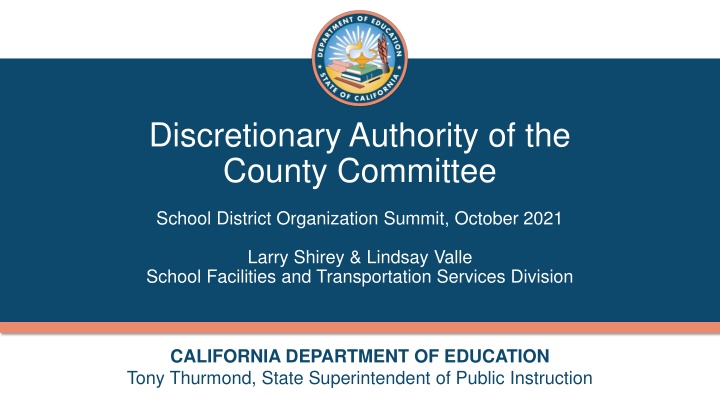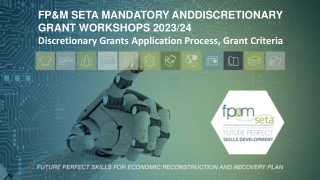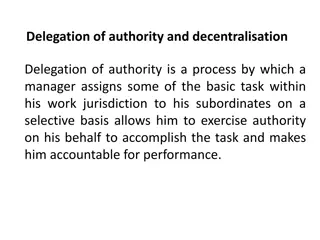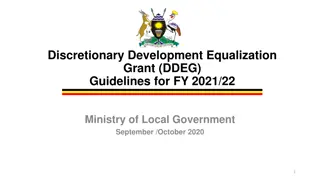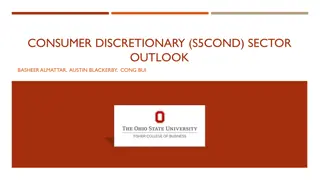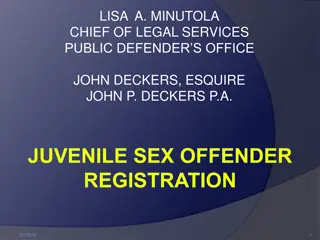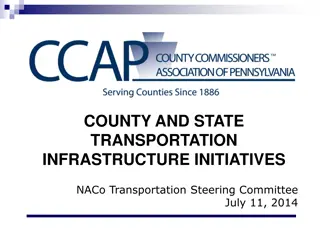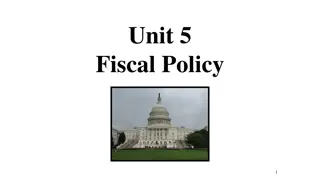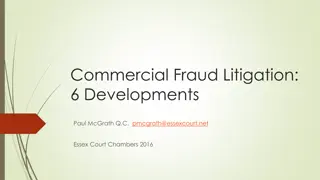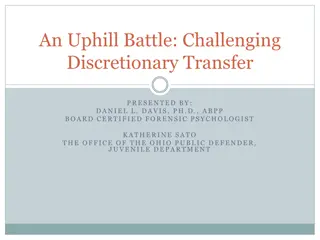Discretionary Authority of the County Committee
School district organization and reorganization in California are governed by the Education Code, providing discretionary authority to entities like the State Board of Education and County Committees. This authority allows for flexibility in evaluating reorganization proposals and determining compliance with criteria. The legislative intent emphasizes local educational needs as the foundation for district reorganizations. Understanding the origins and mechanisms of discretionary authority is crucial for navigating school district organization processes.
Download Presentation

Please find below an Image/Link to download the presentation.
The content on the website is provided AS IS for your information and personal use only. It may not be sold, licensed, or shared on other websites without obtaining consent from the author.If you encounter any issues during the download, it is possible that the publisher has removed the file from their server.
You are allowed to download the files provided on this website for personal or commercial use, subject to the condition that they are used lawfully. All files are the property of their respective owners.
The content on the website is provided AS IS for your information and personal use only. It may not be sold, licensed, or shared on other websites without obtaining consent from the author.
E N D
Presentation Transcript
Discretionary Authority of the County Committee School District Organization Summit, October 2021 Larry Shirey & Lindsay Valle School Facilities and Transportation Services Division CALIFORNIA DEPARTMENT OF EDUCATION Tony Thurmond, State Superintendent of Public Instruction
Legal Reminder Advice/opinions offered in this presentation and by our staff today are not legal opinions nor do they necessarily represent official positions of the California Department of Education. Such advice/opinions are exemplary and are not binding on local educational agencies or other entities. Except for statutes, regulations, and court decisions that may be referenced herein, compliance is not mandatory. [Education Code Section 33308.5]
Todays Agenda Legislative Intent Origin of Discretionary Authority Discretionary Authority of the State Board of Education Legal Challenges to Discretionary Authority Discretionary Authority of the County Committee Identification of Compelling Reasons Who Matters?
Starting Point Legislative Intent of School District Reorganization The Education Code (EC) governs the process and requirements for school district organization and reorganization. EC Section 35500 establishes the legislative intent for school district reorganizations as follows: It is the intent of the Legislature to utilize the organization of districts as they existed on January 1, 1981, and local educational needs and concerns shall serve as the basis for future reorganization of districts in each county. [emphasis added]
Origin of Discretionary Authority The Education Code provides discretionary authority through the language used (e.g., may approve , substantially met ) Provision of regulatory authority (5 CCR 18573, EC Section 35750) While the School District Organization Handbook, along with SBE regulations, provides a guide to evaluating some of the criteria, the SBE or County Committee determines whether each condition is substantially met based on its own analysis and judgement, within the context of the specific reorganization proposal.
Discretionary Authority of the SBE As discussed on the previous slide, the SBE is provided broad latitude to exercise discretionary authority in addressing school district organization matters. Statute further provides the SBE with the authority to waive any of the minimum threshold conditions if it finds determines that it is not practical or possible to apply the criteria of this section literally, and that the circumstances with respect to the proposals provide an exceptional situation sufficient to justify approval of the proposals. [EC Section 35753(b)] SBE discretionary authority has been challenged (unsuccessfully) in past decades.
Legal Challenges to Discretionary Authority That authority has not only been upheld in court but, in certain cases, it has also expanded. Examples: Meeting minimum standards (EC Section 35753 conditions) does not compel approval (Hamilton v. SBE, 1981). SBE hearing of appeals is a de novo process (San Rafael ESD v. SBE, 1999).
Discretionary Authority of the County Committee EC sections 35500, 35709 and 35710 are the basis for County Committee school district reorganization proposal approvals. EC sections 35709 and 35710 both state that the County Committee may approve the petition for which it has determined the minimum threshold standards of EC Section 35753 (a) are substantially met. The use of the word may in these subdivisions denotes discretion to approve. SBE authority to waive minimum threshold standards [EC Section 35753 (b)] does not apply to the County Committee.
Review of County Committee Discretionary Authority 1. County Committee determines all EC Section 35753(a) criteria are substantially met? [EC 35709 or 35710] a. If one or more criteria is not substantially met, committee must disapprove petition. b. If all criteria are met, move to Step 2. 2. County Committee determines there is a compelling reason to approve? [EC 35500] a. If no, then committee must disapprove petition. b. If yes, then committee may approve petition.
Unpacking the Compelling Reason Finding Disapprove if either County Committee finds there is no compelling reason to approve, or County Committee finds a compelling reason to disapprove (e.g., proposal exacerbates an existing educational concern or need or it creates a new concern or need). Approve if County Committee finds there is a compelling reason to approve (i.e., proposal addresses education concern or need [EC Section 35500])
What is a Compelling Reason? Compelling reason is not defined in statute or through regulation. However, it can be viewed in two ways: The court in Hamilton v. SBE (1981) established it as a standard of legal principle. As a value judgement the County Committee can say to the petitioners that none of the reasons provided for the reorganization are compelling enough to support the proposal. The term compelling is like the words sufficient, or adequate, or reasonable.
Whose Needs and Concerns Should Be Considered? County Committees should consider educational needs and concerns of all students in the territory over which is presides, not just the students in the area proposed for reorganization. This concept is part of the Bylaws of most County Committees with such a document.
Summary The Legislature has provided general direction regarding intent behind reorganization. It is the intent of the California Legislature that local educational needs and concerns serve as the basis for school district reorganization (EC Section 35500). The conditions listed in EC Section 35753 (a) are minimum threshold standards; meeting these minimum standards does not compel approval (Hamilton v. SBE, 1981). If the County Committee determines the conditions are substantially met, it may approve a proposal. The County Committee may disapprove a proposal even if all minimum threshold standards set forth in EC Section 35753 (a) are substantially met. The County Committee should disapprove the proposal if either: 1) the proposal does not substantially meet the minimum standards, or 2) there is no compelling reason to reorganize district, or 3) there is a compelling reason to disapprove the reorganization.
Discretionary Authority is an Ally Perhaps the strongest ally the County Committee has in making decisions on reorganization proposals is discretionary authority. The courts have made it very clear that discretionary authority is at the heart of the district organization decision-making process. However, County Committees often appear uncomfortable about embracing discretionary authority.
Sequence of Actions Minimum threshold standards: A County Committee cannot approve a reorganization unless it finds all minimum standards are substantially met. Compelling reason: Is there a local educational need or concern that is addressed by the proposed reorganization?
Review of Minimum Threshold Standards County superintendent determines how minimum threshold standards are examined and whether to provide a recommendation to the County Committee. Examination of the standards usually is through one of the following ways: Outside consultant (typically contains a recommendation). COE staff (with or without a recommendation). No examination (let the County Committee sort through the issues on its own from public hearing, petitioner, and district presentations of information).
Action on Minimum Threshold Standards Regardless of what (or how) information on each standard is presented, the County Committee must determine if the standards are substantially met. There is no statutory or regulatory requirement regarding how this is accomplished. CDE recommends that each standard be a separate agenda item, with County Committee discussion and action.
Compelling Reasons If the County Committee determines that all nine minimum standards are substantially met, it must then determine if there is local educational need or concern that the reorganization addresses (Legislative intent). The courts have made it clear that the determination that all of the standards are substantially met is not the compelling reason to approve a reorganization. However, that sometimes is the easy way out for the County Committee.
Establish Compelling Reason Foundation As part of the County Committee agenda item to either approve or disapprove a reorganization, COE staff could remind the Committee that: Substantially meeting minimum standards is the initial hurdle that the reorganization proposal must clear before the County Committee can determine whether there is a compelling reason to reorganize districts. There is legislative intent behind reorganizing school districts.
Examine Reasons for the Reorganization Common reasons cited in reorganization proposals: Community identity. Safer commutes. Access to schools with higher test scores or more programs. Problems with current district. Are there compelling reasons to disapprove the proposal? Examine reasons provided by those opposing the proposal.
Remember! District reorganization is a structural/administrative change. It is not a parental or school choice option like establishing a charter school. Charter schools: Guidance is to approve unless there is a reason to disapprove. District reorganization: Guidance is to disapprove unless there is a reason to approve.
